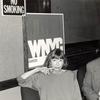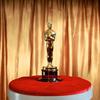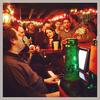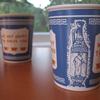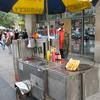Steven Valentino appears in the following:
The Hudson Is Full of Tiny Plastics. And You May Be Too.
Tuesday, March 24, 2015
Listen to 30 Years of Leonard Lopate in Under 3 Minutes
Thursday, March 05, 2015
2015 Oscar Winners on The Leonard Lopate Show
Monday, February 23, 2015
Tab Party: 5 Things We Can't Turn Into Radio Segments This Week
Thursday, February 05, 2015
A Compendium of Dips
Thursday, January 29, 2015
Could an Anti-HIV Drug Discourage Condom Use?
Wednesday, July 23, 2014
New drug Truvada can prevent HIV infection when taken daily, but it faces some resistance in the gay community over fears that it will result in other risks to health.
A Pill to Stop HIV: Here's What You Need to Know
Thursday, June 26, 2014
Our Favorite Movie Musical Numbers
Wednesday, June 25, 2014
Two Lopate Show producers -- and movie musical lovers -- share their favorite numbers from films like Funny Face and Sweet Charity.
Come to Sing, or Don't Come at All
Friday, March 28, 2014
Every night, dozens of customers pile into this tatty basement for the Marie’s Crisis experience: A sloppy, earnest evening of belting out American standards.
Proposed Ban on Microplastics in New York State
Wednesday, February 12, 2014
Attorney General Eric Schneiderman and Long Island Assemblyman Robert Sweeney announced new legislation this week which would ban plastic microbeads, the tiny abrasive particles commonly used in personal care products. The legislation would make New York State the first in the country to outlaw the beads, which are turning up in waterways and fish. Last month we spoke with Rolf Halden, Director of the Center for Environmental Security at Arizona State University, and Sherri Mason, Associate Professor of Chemistry at SUNY Fredonia about why microplastics are hazardous to the environment. You can listen to that conversation above.
Drawing Guantanamo
Thursday, September 26, 2013
Janet Hamlin has been the sole court illustrator documenting the trials at the US Prison at Guantanamo Bay, Cuba since 2006. Her book, Sketching Guantanamo will be published in October.
Valentino: How did you come to work at Guantanamo?
Hamlin: The Associated Press was one of my clients and it was their turn to pool report from Guantanamo. They sent me for the first three trips and after that I started going as a freelancer. So, I kind of had a rut in the road, having been there the first three times. And it is a strange venue.
Valentino: What’s strange about it?
Hamlin: Usually, in the United States we can sit in the same physical space as the charged person, but in GITMO we are in a walled, glassed-in booth in the back that’s soundproof. So, you’re drawing from a distance. You’re drawing from the back and you’re drawing with a sound delay. The other thing is you’re dealing with is the constraint of your work being signed off by the Pentagon or the Homeland Security officer. Everything has to be signed and labeled before it can go out to media.
To See How New York Can Survive Flooding, Look to Hamburg
Friday, September 20, 2013
To get a good sense of a what a floodproof city can look like, check out Hafen City in Hamburg, Germany.
A Totally Incomplete Collection of Campaign Jingles: Part 1
Wednesday, September 26, 2012
When he accepted the presidential nomination earlier this month, Barack Obama joked about the nature of modern politics—and the amount of money required to run a media campaign— by saying “If you're sick of hearing me approve this message, believe me, so am I.” There was sustained applause.
The Museum of the Moving Image has a great collection of Presidential campaign advertisements and posted below are a few examples of the lost art of the political jingle. The lyrics in most of these ads aren’t exactly at Cole Porter levels of word-play. A few notable clunkers include: “He is the gov that brings the dove of peace and joy” and “Reachin’ out across the sea, makin’ friends where foes used to be.” But many of them are catchy.
Take this 1952 ad for Adlai Stevenson. The Democratic governor of Illinois may have lost two consecutive Presidential elections, but he did produce at least one hummable advertisement. The show-tunes vote has been an essential swing constituency ever since.
More jingles after the jump--->
Object #1: The Greek Coffee Cup
Friday, March 16, 2012
The top object in our countdown is perhaps the most accidental of New York icons. In its heyday the Anthora cup, with its crisp blue and white Greco design, was the way you drank hot beverages on the go. But, as Leonard pointed out, sometimes the coffee itself wasn’t always that great. Oh, the power of nostalgia. (continue reading)
Object # 2: The Subway Token
Friday, March 16, 2012
It might seem odd that our listeners chose an object that hasn’t been used in New York City for nearly a decade as number two on our list. But as Robert Del Bango of the New York City Transit Museum told us, it’s actually “a very smart object” to tell the story of New York. (continue reading)
Object # 3: The Food Cart
Wednesday, March 14, 2012
Eating outside has always been a part of the New York City way of life. “The early colony was downtown,” Fabio Parasecoli of The New School told us. “Food had to be brought to southern Manhattan from the nearby farms.” Often, that food was sold and consumed on the street. (continue reading)
Object #4: The Oyster
Monday, March 12, 2012
Our listeners chose the lowly oyster—not the exalted bagel— as the only edible object on our list of ten items which define New York City. In a number of ways, the rise and demise of the harbor oyster is the story of the city itself.
“The history of New York is the history of gobbling up everything,” Mark Kurlansky, author of The Big Oyster explains. “When there was deer and elk and lynx and all sorts of things on Manhattan, people ate that stuff. The wild fruit trees that once covered New York are all gone too. It reaches the point where the one natural resource that’s left to eat are oysters.” And by most accounts, early New Yorkers ate oysters by the bucketful. They were harvested by the Lenape Indians and loved by the Dutch and British colonists. The bivalve was once synonymous with New York City. “Today, people come to New York and take in a Broadway Show—it used to be that people from all over the world would come here for the oysters,” Kurlansky said. (continue reading)
Object #5: 18th-Century Ship Excavated from WTC Site in 2010
Monday, March 12, 2012
This object is an example of New York’s past colliding with its present.
“We’ve never seen a boat like this before,” Warren Reiss a maritime historian and archeologist at the University of Maine explained. “There are a number of things about how this vessel was built that we are still scratching our heads about.” Reiss was the principal investigator of a ship the New York Times dubbed the “S.S. World Trade Center.” “We don’t even know if it had one mast or two,” Reiss said. (continue reading)
Object #6: Frank O'Hara's Lunch Poems
Wednesday, March 07, 2012
It was slightly surprising that Frank O’Hara’s 1964 collection Lunch Poems came in at number six on our list, but it turns out to be a very good way of looking at New York City. As NYU professor Lytle Shaw, author of the book Frank O’Hara: The Poetics of Coterie explains “Lunch Poems is a condensed and highly accessible book that is smaller than a subway map.” That feature makes it easy to take the book anywhere. Shaw described it as having the potential to “acclimatize you to the things New York has to offer.” (continue reading)
Object #7: The Brooklyn Bridge
Monday, March 05, 2012
The seventh object on our list violates the central rule of our contest that it “must be able to fit in a museum”—but just this once we’ll make an exception. Richard Haw, a professor at CUNY and author of the book, Art of the Brooklyn Bridge: A Visual History, told us that the bridge is a particularly good selection for this project. “It helps illuminate different parts of the history of the New York: political, economic, demographic, social, transport, technological, literary and artistic.” (continue reading)

